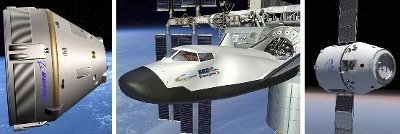
Yesterday, NASA held a press conference to communicate the latest updates on the status of its Commercial Crew Program (CCP), the program of funding for certain business partners who are working to build spacecraft capable of carrying people into space.
In August 2012, NASA announced the names of the partner companies that would be funded in the third phase of the CCP, called the Commercial Crew integrated Capability (CCiCap). They are Sierra Nevada Corporation or SNC, Space Exploration Technologies or SpaceX and The Boeing Company or Boeing.
In December 2012, those companies obtained an additional funding of about $10 million each for the first phase of the Certification Products Contract (CPC). It’s a certification plan that has the purpose of obtaining safety in flights developing engineering standards, testing and analyzes of the projects of the crew transport systems.
During the first phase of the CPC contract, which will run from January 22, 2013 to May 30, 2014, the companies will develop together with NASA ways to implement the requirements for safety and performances. Then, the second phase will see a competition between the companies in the actual development of the spacecraft up to the test of crew transport to the International Space Station.
To those companies we have to add Blue Origin, which in recent years received funding from NASA earlier phases of the CCP program. The company, created by Amazon founder Jeff Bezos, is still going forward with the development of its transport system for suborbital and orbital flights. The collaboration with NASA continues even if the company isn’t receiving any more funding.
SpaceX plans to include a verification test of the safety of a launch abort of its Dragon spacecraft which should take place in April 2014. If this and other tests are successful, the test of sending crew to the International Space Station should be achieved by 2015.
Sierra Nevada Corporation plans to make the first test of autonomous flight of its Dream Chaser in the first quarter of this year launching it from an airplane. The following tests should be similar to those conducted by NASA with the Enterprise, the Space Shuttle prototype. If the suborbital and orbital flight tests are successful, the orbital flights with crew could begin in 2016.
Boeing will proceed with the testing of its spacecraft CST-100 and if they’re successful the company has proposed to make an orbital flight with crew in 2016.
Obviously, the plans will be updated over time because they depend on the results of the tests. In the U.S.A. they’re all very motivated because at the moment they have to rely on the Russians to send personnel to the International Space Station and back to Earth. Besides the issue of prestige there’s also the cost because clearly they prefer to pay American companies rather than Russian ones.
Therefore, we have to wait over two years to see the fruits of these plans, on the other hand they’re developing technologies more advanced than those used in previous decades. In long term space voyages should become far cheaper.
[ad name=”Google Adsense 468″]

